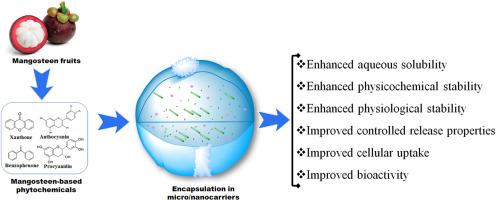Recent advances in delivering mangosteen-based phytochemicals using promising micro/nanocarriers: Formulation, outcomes, and perspectives
IF 15.1
1区 农林科学
Q1 FOOD SCIENCE & TECHNOLOGY
引用次数: 0
Abstract
Background
Nowadays, mangosteen (Garcinia mangostana L.) is getting more attention from researchers because of the rich source of bioactive phytochemicals in its fruit shell including xanthones, anthocyanins, benzophenones, etc. The bioactivity of these phytochemicals cannot be achieved fully during the application as/in functional materials due to their physicochemical and physiological instability. Therefore, encapsulation of mangosteen-based phytochemicals (MPC) using promising carriers could be one of the possible ways to overcome these limitations as well as to ensure controlled release properties and enhanced bioactivity.
Scope and approach
This review first highlights the physicochemical properties and biological potentials of mangosteen. Thereafter, our review comprehensively focuses on the controlled delivery of MPC using advanced carrier systems.
Key findings and conclusions
Encapsulation of mangosteen-based phytochemicals (MPC) using lipid-based particles (e.g. liposomes, solid-lipid particles, and niosomes), polymeric particles (nanocapsules and nanospheres), β-cyclodextrin-based inclusion complexes, ethyl-cellulose and methyl-cellulose blends, poly(ethylene glycol)-based polymeric particles, emulsions-based particles could improve the physicochemical stability, controlled release properties, and bioactivities. Only a single study has been found on MPC-loaded nanofiber mats, bacterial cellulosic nanofiber film, nanomicelles, and nanosponges with improved bioactivity. Thus, more research is required on these promising carriers to develop MPC-based functional materials with improved effects. In conclusion, encapsulating MPC in promising micro/nanocarriers could allow us to develop some unique functional materials with exceptional bio-efficacy.

利用前景看好的微/纳米载体输送山竹果植物化学物质的最新进展:配方、结果和前景
背景山竹果(Garcinia mangostana L.)果壳中含有丰富的生物活性植物化学物质,包括氧杂蒽酮、花青素、二苯甲酮等,因此受到研究人员越来越多的关注。由于这些植物化学物质在物理化学和生理上的不稳定性,它们在功能材料中的应用无法充分发挥其生物活性。因此,使用有前景的载体封装山竹果类植物化学物质 (MPC) 可能是克服这些限制、确保控释特性和增强生物活性的可行方法之一。本综述首先强调了山竹果的理化特性和生物潜力,然后全面介绍了利用先进载体系统控制山竹果植物化学物质(MPC)的给药。利用脂质体颗粒(如脂质体、固态脂质颗粒和niosomes)、聚合物颗粒(纳米胶囊和纳米球)、β-环糊精包合物、乙基纤维素和甲基纤维素混合物、聚乙二醇基聚合物颗粒、乳液基颗粒包囊山竹果植物化学物质(MPC),可以提高理化稳定性、控释特性和生物活性。目前仅有一项研究涉及载 MPC 的纳米纤维毡、细菌纤维素纳米纤维膜、纳米细胞和纳米海绵可提高生物活性。因此,需要对这些前景广阔的载体进行更多研究,以开发出具有更好效果的基于 MPC 的功能材料。总之,将 MPC 封装在有前景的微型/纳米载体中,可以开发出一些具有特殊生物功效的独特功能材料。
本文章由计算机程序翻译,如有差异,请以英文原文为准。
求助全文
约1分钟内获得全文
求助全文
来源期刊

Trends in Food Science & Technology
工程技术-食品科技
CiteScore
32.50
自引率
2.60%
发文量
322
审稿时长
37 days
期刊介绍:
Trends in Food Science & Technology is a prestigious international journal that specializes in peer-reviewed articles covering the latest advancements in technology, food science, and human nutrition. It serves as a bridge between specialized primary journals and general trade magazines, providing readable and scientifically rigorous reviews and commentaries on current research developments and their potential applications in the food industry.
Unlike traditional journals, Trends in Food Science & Technology does not publish original research papers. Instead, it focuses on critical and comprehensive reviews to offer valuable insights for professionals in the field. By bringing together cutting-edge research and industry applications, this journal plays a vital role in disseminating knowledge and facilitating advancements in the food science and technology sector.
 求助内容:
求助内容: 应助结果提醒方式:
应助结果提醒方式:


